The Ultimate Guide to Concrete Finishes: 9 Different Types of Finishes That You Need to be Using
Togal.AI
|
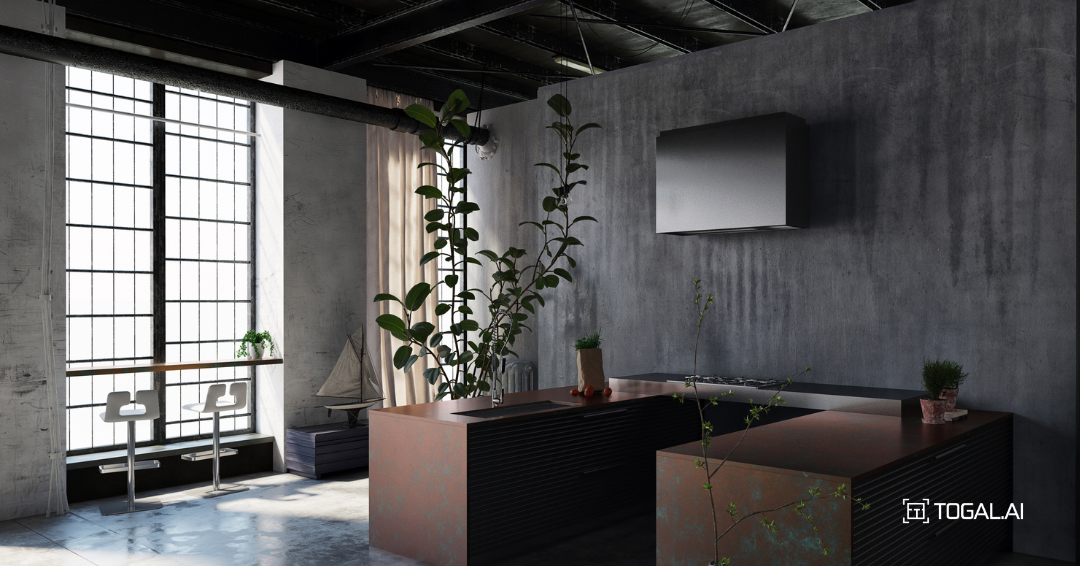
Concrete has long maintained its popularity for floor finishes because of its durability, strength, and versatility. Because of these qualities, concrete slabs have been used as the preferred choice for flooring in garages, basements, patios, landscaping, and utility areas.
Nowadays, the use of concrete finishes goes beyond its functional properties. Modern industrial design trends have sparked fresh interest in creative ways that concrete can be used that fulfill both aesthetic and decorative objectives.
Keep reading to learn more about the different types of concrete finishes, their advantages, and their applications.
What are Concrete Finishes?
Concrete is a mixture made up of cement and water combined with aggregates such as sand, gravel, and crushed stone. The process of hydration chemically alters these components and hardens them into one of the most durable and versatile construction materials on Earth.
It is malleable when newly mixed, making it easy to incorporate into a space. It also becomes tough, and durable when hardened. Concrete finishes withstand hard traffic whilst retaining its beauty. When properly maintained, concrete can last up to a hundred years.
Concrete finishes are an excellent and cost-effective way of adding design on top of superior functional properties.
Benefits Of Using Concrete Finishes
Compared to other floor finishes such as hardwood, laminates, ceramic tiles, and rubber, concrete finishes offer superior resilience against wear with low maintenance.
Concrete patio finishes are perfect for heavy-duty areas and offer a variety of customizations, textures, colors, and designs. Concrete flooring is also preferred in hot weather conditions because of its ability to stay cool making it perfect for temperate climates.
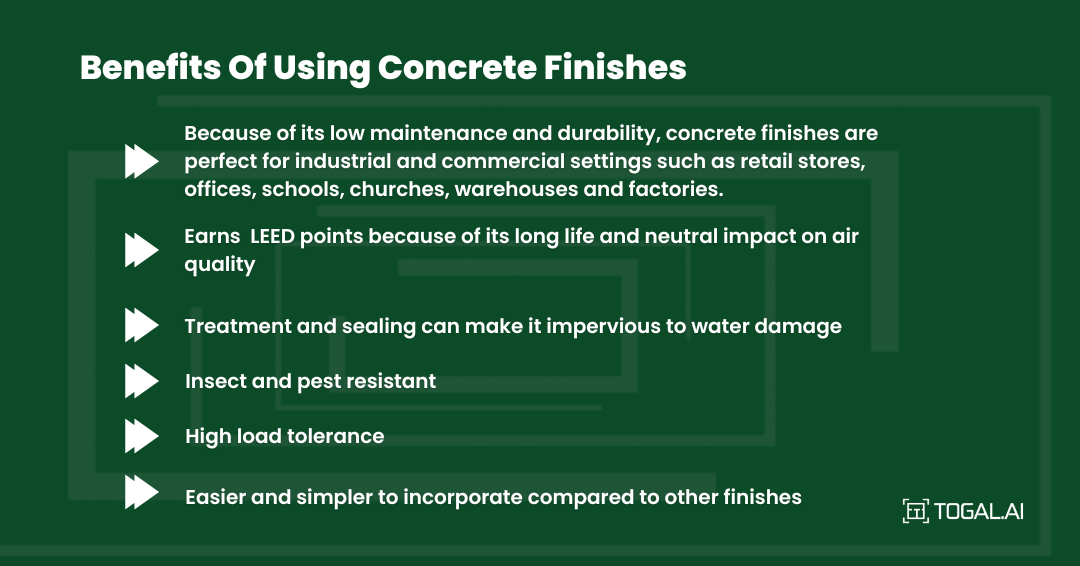
Different Types Of Concrete Finishes
There are many types of concrete finishes being used by general contractors.
Due to concrete’s strength and unique minimalist charm, there are many types of concrete finishing options that are available to suit every design and that are being used by general contractors. These range from smooth trowel finishes used in driveways to textured concrete finishes used in pools, to fancy polished finishes used in museums and art galleries.
Below are the most commonly used types of concrete finishes.
Troweled Finish
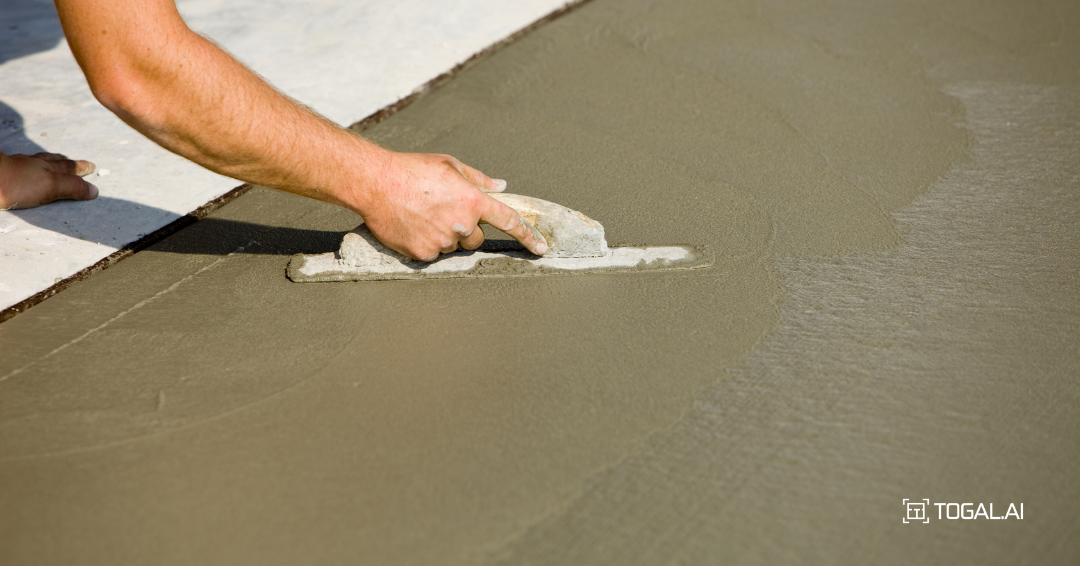
Uses: indoor spaces, roof slabs, garages, utility areas, commercial areas, walls
Advantage: budget-friendly, multi-purpose use, faster to create than other concrete finishes
Disadvantage: Not advisable for outdoor spaces, slippery when wet, not as aesthetic as the other concrete finish options
Description:
Also known as “smooth finish”, this is the most basic concrete finish. Despite its simplicity, perfecting a smooth, level and blemish-free surface is tough to master. The wet concrete must be leveled, floated, and troweled properly before it can harden into a smooth, glossy finish.
Masonry workers make use of a screed and trowel to achieve this kind of finish. Concrete screeds are usually made of metal or wood. These screeds are dragged and pulled along the surface of the concrete. The surface is then smoothed further with a trowel, removing the smaller lumps and bumps that the screed was unable to remove. On large commercial projects, power trowels that resemble giant fan blades are used.
Broom Finish

Uses: outdoor spaces, driveways, walkways, parks, swimming pools, patios
Advantage: offers increased traction perfect for outdoor settings and near sources of water
Disadvantage: Water and dirt collects between the ridges
Description:
A broom is dragged across the surface of the concrete after it has been smoothed to create ridges that provide traction control. Although not as aesthetically pleasing compared to other concrete finishes, the ridges provide a rough and non-slip surface for spaces that prioritize safety such as swimming pools and walkways.
Swirl concrete finishes are an advanced type of broom finish that add more finesse to a broom pattern finish. It is produced by swirling a broom to create uniform swirled imprints, arc patterns, or other similar geometric designs.
The depth and width of these ridges on concrete broom finish types can be altered by choosing different sizes of bristles.
Stamped Concrete Finish
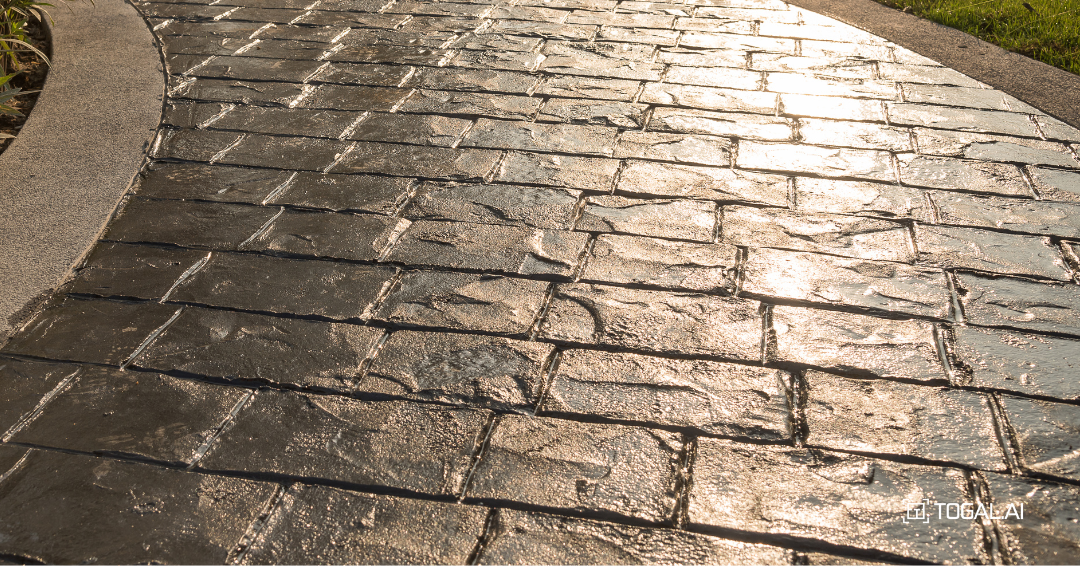
Uses: outdoor spaces, recreational areas, parks, patios, walkways, landscaping
Advantage: endless customizations and designs may be used on the concrete to achieve the desired look, and decorations are visually-appealing
Disadvantage: the etched designs create weaknesses on the surface that decreases its durability, are prone to cracking and freezing, not suitable for heavy loads such as vehicular traffic
Description:
Stamped concrete finishes, also known as textured or imprinted concrete, are a type of outdoor concrete finish that is created by pressing plastic, wood, or metal panels on freshly leveled concrete. The result is a type of concrete finish that mimics the look of bricks, natural stone, tiles, and slate.
Stamped concrete finishes are a creative way to decorate outdoor spaces. When color is applied to these patterns, the effect is mesmerizing. Workers responsible for stamping concrete require special training and professional equipment to work with hardeners, release agents, and forms.
Salt Finish

Uses: pool decks, near water sources, large fountains
Advantage: skid resistant and increases traction for places near water sources whilst remaining visually appealing and budget-friendly
Disadvantage: small pits in the concrete collect water that may eventually lead to cracking if not properly sealed
Description:
A salt finish concrete surface is achieved by inserting coarse rock salt crystals usually between ⅛” to ⅜” in diameter on freshly poured concrete surfaces and washing them off with streams of water after the concrete is set.
The surface of this kind of concrete finish is marked by tiny pits that increase traction and provide a decorative non-slip surface most suitable for pool decks.
Exposed Aggregate Finish

Uses: outdoor spaces, driveways, walkways, parks, swimming pools, patios
Advantage: visually pleasing with non-skid properties that can add a unique touch to outdoor spaces
Disadvantage: costlier compared to other types of finishes, prone to wear if not properly sealed
Description:
The exposed aggregate finish is a popular type of textured concrete finish. It is produced by removing the top layer of freshly poured cement to uncover coarse decorative aggregate. Aside from decorative purposes, the exposed aggregates give the surface added traction that is especially useful for outdoor settings.
It is common practice to use richly colored natural stones such as quartz, granite, basalts, and limestone for a truly decorative look. Alternatives also include recycled glass or seashells.
Stenciled Finish

Uses: indoor spaces, patios, walkways, landscaping
Advantage: less expensive alternative to stamped concrete finishes, adds a decorative touch to concrete surfaces
Disadvantage: prone to cracking, less durable
Description:
Stenciled finishes are similar to stamped finishes in terms of the desired goal to incorporate a decorative appeal on the surface but differ in their execution. Stenciled finishes, as the name implies, make use of paper stencils rather than specialty stamps.
This type of concrete finish generally requires less expertise and is easier to install. Workers can cover large areas without having to wait for the stamped slabs to cure. A stencil is laid on top of freshly poured concrete and gently worked into the surface. Once the concrete partially cures, the stencil is then removed revealing the design underneath.
Commonly used stencil patterns mimic the look of bricks, tiles, natural stone, geometric shapes, and cobblestones.
Polished Finish
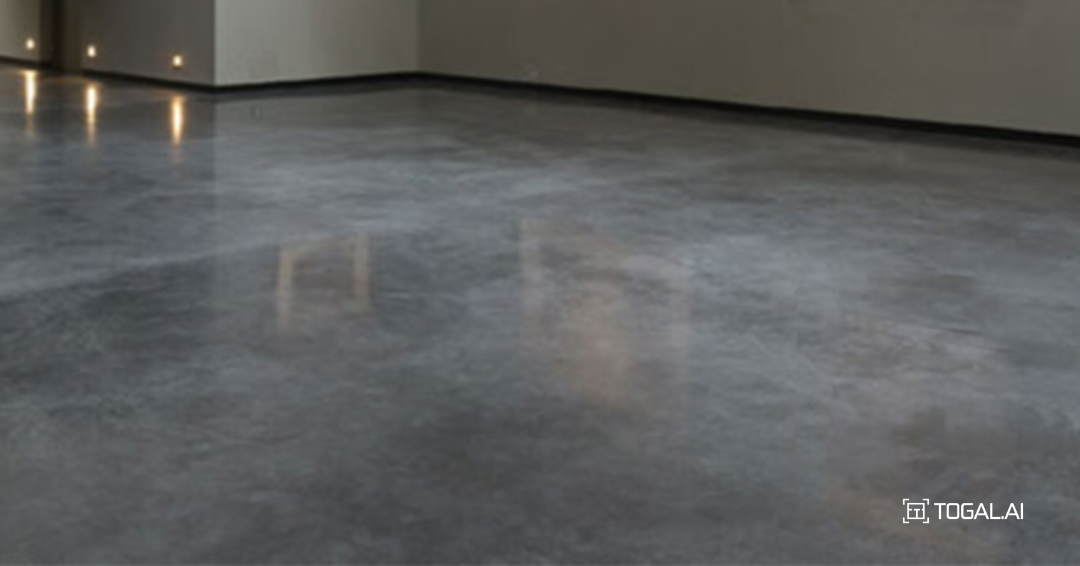
Uses: indoor spaces, large warehouses, retail stores, showrooms, office buildings, residential spaces
Advantage: trendy and modern look, durable
Disadvantage: not suitable for outdoor settings and heavy vehicular traffic
Description:
The polished finish on a concrete surface is achieved through the use of heavy-duty machines fitted with diamond abrasives that grind down a concrete surface to the desired degree of shine and smoothness. Chemical hardeners and special coatings are also added during the polishing process to help protect against water damage and stains.
Many modern industrial-style interiors are built with a polished concrete finish because it’s both beautiful and durable. The high degree of customization makes polished concrete an ideal finish for a variety of applications.
Colored Finish

Uses: outdoor spaces, indoor spaces, commercial facilities, industrial buildings, sports facilities, recreational spaces
Advantage: unlimited choice of colors, low maintenance
Disadvantage: colors may fade as the concrete ages, longer application process, may peel in high foot traffic areas
Description: Coloring is a great way of finishing off concrete surfaces. It offers limitless color combinations and creative ways of using colors to bring concrete finishes to life. Some colors such as pigments are incorporated during the concrete mixing stage while other techniques such as staining are applied when the concrete has cured.
Epoxy Resin Finish
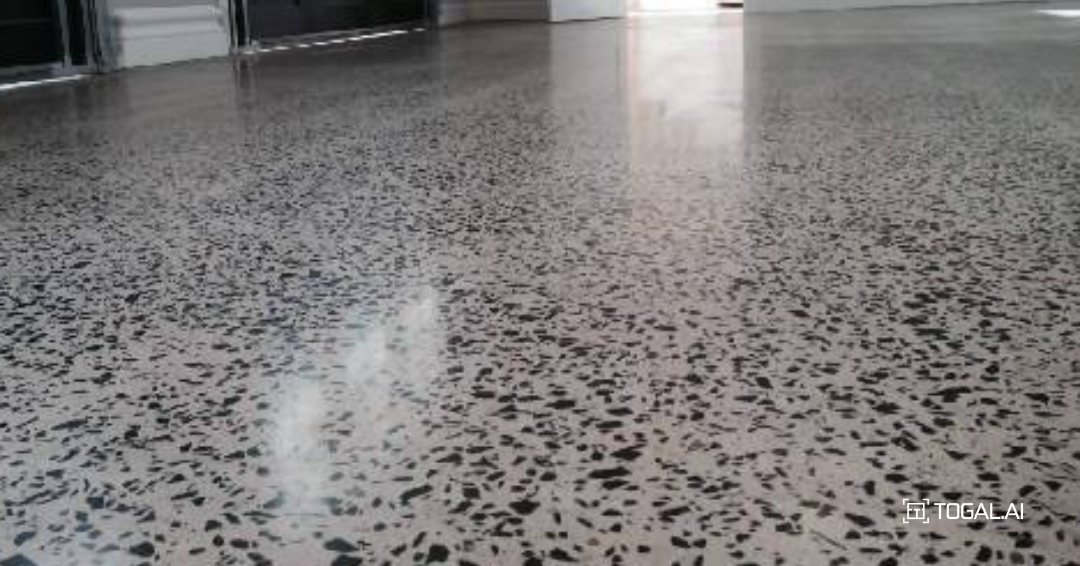
Uses: indoor spaces
Advantage: stunning aesthetics, extremely durable, high-end look
Disadvantage: expensive, laborious
Description: Epoxy resin finishes are one of the most popular ways to seal and protect concrete finishes. Floor epoxy is a form of paint composed of a liquid catalyst and a liquid hardener that are combined just before application. The epoxy hardens through a chemical reaction that produces a high-gloss, vibrant, and extremely durable finish that is frequently used in high-traffic commercial applications.
Frequently Asked Questions
1. How do you maintain polished concrete flooring?
Polished concrete floors require daily dust mopping to remove dirt and grime accumulation that can abrade the surface. Cleaning may also be done with clean water and all-purpose soap. Avoid using chemicals such as bleach that can ruin the concrete finish.
2. Why does newly poured concrete crack?
Cracking is primarily caused by shrinkage. Concrete shrinks as water evaporates and the mixture hardens. Contractors frequently add more water than required because it makes the mixture easier to work with, this reduces the strength of the concrete that can cause it to pull apart once it cures. Reduce excess water and make sure to adhere to the cement ratios stipulated on the cement bag to ensure the best results.
3. How long does concrete take to dry?
Concrete partially hardens anywhere from 24 to 48 hours. It takes about a week to cure to 75% strength and 28 days for it to achieve full strength.
Leverage Togal.AI For Takeoffs
Concrete finishes offer more than just strength and durability. Its versatility allows for an endless array of decorative options that bridge both design and function. Concrete finishes come in many forms and types. They range from simple trowel finishes to stunning high-end epoxy resin finishes.
Are you a general contractor currently doing a cost estimation and material takeoff? Compared to the process of concrete finishing, material takeoffs completed by Togal.AI can be completed in seconds with 99% accuracy. Our software is an AI-powered estimating software that has helped estimators and general contractors fulfill more bids and increased their chances of winning more work.
To learn how Togal.AI can seamlessly integrate with your workflow, book a demo today.
